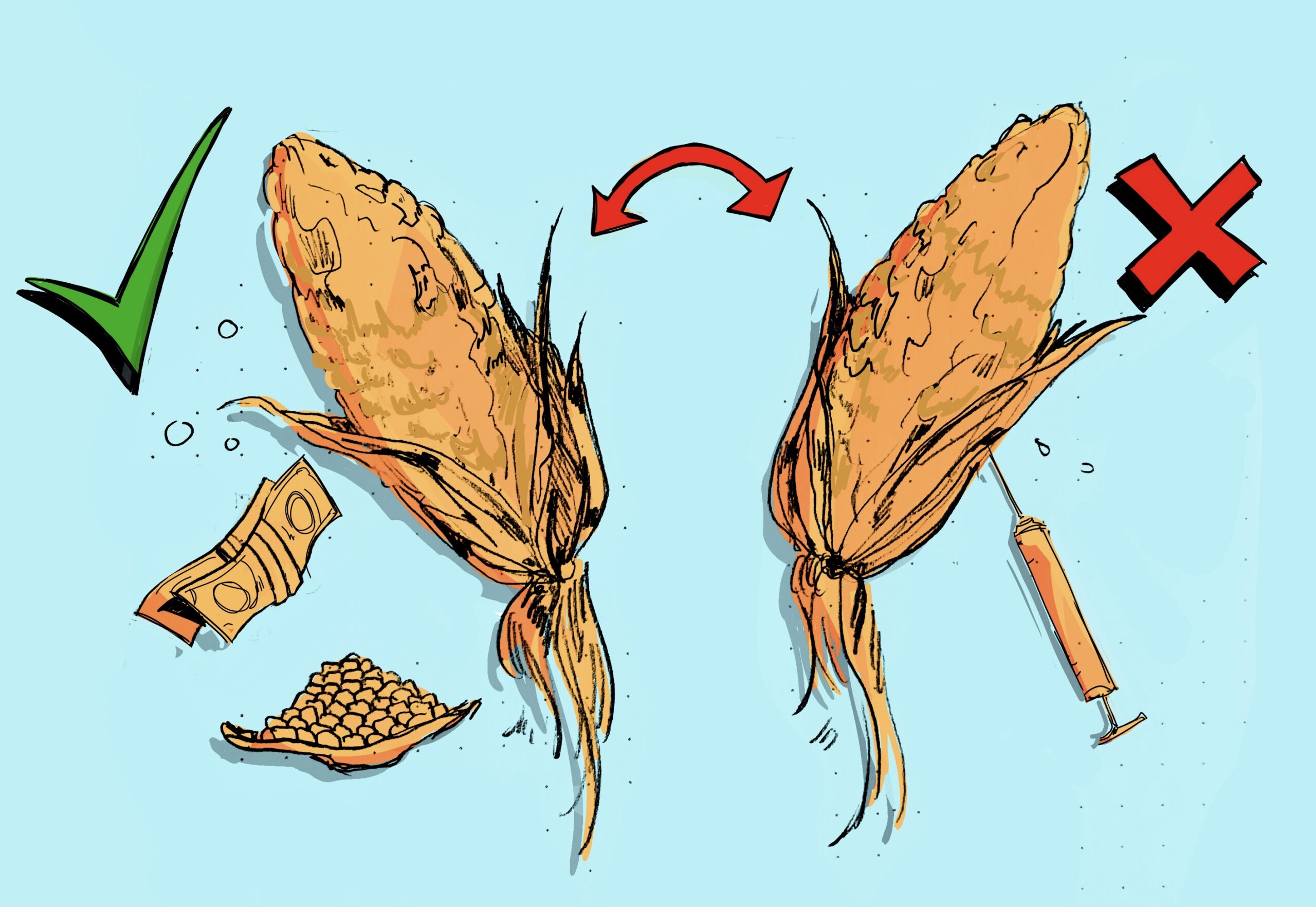
Introduction:
When one thinks of food modification, stories from the last decade about food that is abnormally large or long lasting are often the first that come to mind. In reality, the first form of food modification can be traced back to 29,000 B.C.: the oven. While it is not often considered as such, cooking and its associated processes are a form of food modification. The application of heat to denature proteins in meat, adding salt to extract water and dry out fruit, even squeezing lemon over a salad to increase the response of the tongue’s flavor receptors are all examples of food modifications that a majority of people engage with on a daily basis. In fact, the ability to manipulate food has progressed so much that an entirely new field was born of the idea: molecular gastronomy.
Molecular gastronomy is defined as a focus on physical and chemical changes during cooking. Chefs of this modern science bring food to new heights: solids turned to foam, fruit turned into gelatinized orbs, even apples that taste like meat; all examples of modified food. But why does this form of alteration pass as high-class when topics such as Genetically Modified Organisms (GMOs) seem taboo and unnatural? Although these processes contain more scientific similarities than differences, the social difference could not be larger.
Designer Dishes
Born in 1998 and reaching peak popularity around 2016, molecular gastronomy dominated the culinary world. Photos of brightly-colored, strangely-flavored foam saturated media of all forms. Chefs everywhere poured liquid nitrogen, and turned every possible food into a sphere. Restaurants that focused on molecular gastronomy were a sensation of the time, despite their longevity being akin to that of the foams that adorned their dishes (that is to say, short). But how did chefs of the time perform these flavorful feats of transformation?

The answer is simple: chemistry and food modification. Though not commonly viewed or advertised as such, the deliberate chemical modification of ingredients makes molecular gastronomy possible. When the ever so popular liquid nitrogen gas comes into contact with food, the gas rapidly and evenly forms ice crystals in and around the food, efficiently and thoroughly freezing it to maintain quality and flavor. To create molecular gastronomy’s signature gelatin spheres, chefs introduce alginate or agar to foods, which reacts with calcium chlorinate in the ingredients to form an appealing gelatinous texture. When one chef sought to use milk skin (the film that forms over milk when it is heated, like when making hot chocolate on a stove) in a recipe, he struggled to achieve the correct consistency. He then introduced extra whey protein to the milk to increase the production of small globular proteins. Small globular proteins (SPGs) are responsible for creating colloids, a collection of insoluble particles that are suspended in another medium, like a milk skin floating on milk. Instead of being viewed as strange science experiments, these endeavors bring to mind whimsical and innovative dishes that thrill and delight, rather than unnerve and repulse.
In all cases, such innovation with food evidently requires chemical modification. The minds behind these processes are celebrated– several chemical cooking processes have been named in honor of their creators, such as the Baumé egg, named for Antoine Baumé. The process includes soaking an egg in alcohol, which denatures the proteins in the egg and causes it to coagulate. However, in more industrial contexts, like those behind GMOs, these same chemical processes would not receive the same praise.
Controversial Cuisine
When not specifically investigating the world of molecular gastronomy, the perception of food alteration appears entirely different. Words like genetically modified and chemically enhanced bring to mind images of mutant food, lab-grown and unnatural. The use of biotechnology to alter food, even to increase nutritional value or make agriculture more efficient and sustainable, is negatively viewed. The rise of bioengineered and altered food induced a countermovement of organic, non-GMO, and chemical-free marketing. But are the processes that lead to GMOs and similarly processed foods really that different from the ones that lead to molecular gastronomy?
https://www.flickr.com/photos/30478819@N08/50889479162
One goal of food modification is to make food more nutritious and accessible for communities with limited access. For example, new genetically-modified soybean crops produce healthier oil and require less water to grow, making them a more sustainable and effective crop. This result is achieved by identifying specific drought-reactive genes and amplifying their expression in the crop, creating a more weather-resistant plant. A particularly famous example is Golden Rice, a strain of rice that was genetically engineered to contain vitamin A to help combat vitamin deficiencies in countries where they are prevalent. The rice was modified to specifically contain lycopene, a red pigment found in tomatoes and carrots that gives the rice its golden color and its name. The crop then converts this pigment into a useful form of vitamin A. In both these cases, the modifications directly result in more accessible or more nutritious food for everyone. But why is it that terms like bioengineered and genetically modified receive more attention than the benefits they can produce?
Bioengineered and genetically altered foods are widely viewed as a negative aspect of the biotechnology world. Common fears include introduction of new allergens or possible invasive species arising that could overrun native crops. While the use of genetically modified food and crops prompt valid concern, the benefits of reducing food and nutritional deficiencies should be explored and maximized. At a chemical level, the dishes created in the name of molecular gastronomy and the foods created to increase food access do not differ severely. So why is public perception of these two fields so different?
Converging Confections
When boiled down to a molecular level, the chemical alterations of these two spheres are more similar than different. While one is genetically modified and one is chemically modified, both fields involve food changing states through scientific processes. But one field is viewed as a delightful extravagance, and the other is seen as unnatural. How is it that this difference has occurred?
A possible answer is demographic. Molecular gastronomy is primarily enjoyed by those with the financial means to treat food as a delicacy or as a recreational experience. Instead of viewing food as a conduit of macronutrients, it can be an enriching sensory experience that elevates the meal from everyday to extraordinary. It gains an elevated public perception due to its exclusive status in the culinary world. The use of biotechnology for more accessible food, on the other hand, primarily benefits those who experience food or nutrient insecurity. The focus is on creating a more efficient delivery of nutrients for all, rather than being entertaining or luxe, creating more advanced scrutiny than its extravagant counterpart.
With both fields having their respective strengths, the question then becomes how to maximize the benefits. With the creative elements of molecular gastronomy and the utilitarian aspect of food engineering, there lies the possibility of creating more nutritious, accessible, and fun food for a larger population. Through the humanitarian goals of biotechnology and the social acceptance of molecular biology, a change in the perception of food alteration could create a positive impact on a wide scale, allowing for the positive benefits of altered foods to outweigh their stigma. While food alteration will likely remain a controversial topic for some time, it is important to be mindful of what kind of food modification we accept and what kind we shun. So the next time you turn on your oven, remember that you, too, are capable of chemically modifying your food.
References:
https://blog.thermoworks.com/beef/cooking-low-slow-meat-doing/
https://illumin.usc.edu/from-chemistry-labs-to-the-kitchen-molecular-gastronomy/
https://www.sciencedirect.com/topics/agricultural-and-biological-sciences/molecular-gastronomy
https://www.embopress.org/doi/full/10.1038/sj.embor.7400850
https://www.intechopen.com/chapters/58038
https://allianceforscience.cornell.edu/blog/2018/08/the-gmo-debate/
